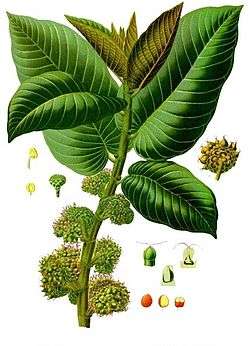Moraceae
| Moraceae Temporal range: 80 Ma Cretaceous - Recent | |
|---|---|
 | |
| Panama rubber tree (Castilla elastica) | |
| Scientific classification | |
| Kingdom: | Plantae |
| (unranked): | Angiosperms |
| (unranked): | Eudicots |
| (unranked): | Rosids |
| Order: | Rosales |
| Family: | Moraceae Gaudich.[1] |
| Genera | |
|
See text. | |
The Moraceae — often called the mulberry family or fig family — are a family of flowering plants comprising about 38 genera and over 1180 species.[2] Most are widespread in tropical and subtropical regions, less so in temperate climates. The only synapomorphy within Moraceae is presence of laticifers and milky sap in all parenchymatous tissues, but generally useful field characters include two carpels sometimes with one reduced, compound inconspicuous flowers, and compound fruits.[3] Included are well-known plants such as the fig, banyan, breadfruit, mulberry, and Osage-orange. The 'flowers' of Moraceae are often pseudanthia (reduced inflorescences).

Classification
Formerly included within the now defunct order Urticales, recent molecular studies have resulted in its placement within Rosales in a clade called the urticalean rosids that also includes Ulmaceae, Celtidaceae, Cannabaceae and Urticaceae. Cecropia, which has variously been placed in Moraceae, Urticaceae, or their own family, Cecropiaceae, is now included in Urticaceae.[4]
Dioecy (having individuals with separate sexes) appears to be the primitive state in Moraceae.[5] Monoecy has evolved independently at least four times within the family.
Genera
The five tribes of Moraceae are: Artocarpeae;[6] Castilleae;[7] Dorstenieae;[8] Ficeae;[9] and Moreae.[10]
|
|
|
|
Footnotes
- ↑ Angiosperm Phylogeny Group (2009). "An update of the Angiosperm Phylogeny Group classification for the orders and families of flowering plants: APG III" (PDF). Botanical Journal of the Linnean Society. 161 (2): 105–121. doi:10.1111/j.1095-8339.2009.00996.x. Retrieved 2013-07-06.
- ↑ Christenhusz, M. J. M., and Byng, J. W. (2016). "The number of known plants species in the world and its annual increase". Phytotaxa. Magnolia Press. 261 (3): 201–217. doi:10.11646/phytotaxa.261.3.1.
- ↑ Judd et al. (2008)
- ↑ Sytsma et al. (2002)
- ↑ Datwyler and Weiblen (2004)
- ↑ GRIN. "Genera in GRIN for tribe Artocarpeae". Retrieved November 26, 2012.
- ↑ GRIN. "Genera in GRIN for tribe Castilleae". Retrieved November 26, 2012.
- ↑ GRIN. "Genera in GRIN for tribe Dorstenieae". Retrieved November 26, 2012.
- ↑ GRIN. "Genera in GRIN for tribe Ficeae". Retrieved November 26, 2012.
- ↑ GRIN. "Genera in GRIN for tribe Moreae". Retrieved November 26, 2012.
References
- Datwyler, Shannon L. & Weiblen, George D. (2004): On the origin of the fig:Phylogenetic relationships of Moraceae from ndhF sequences. American Journal of Botany 91(5): 767-777. PDF fulltext
- Judd, Walter S.; Campbell, Christopher S.; Kellogg, Elizabeth A.; Stevens, Peter F. & Donoghue, Michael J. (2008): Plant Systematics: A Phylogenetic Approach. Sinauer Associates, Inc. Sunderland, MA.
- Sytsma, Kenneth J.; Morawetz, Jeffery; Pires, J. Chris; Nepokroeff, Molly; Conti, Elena; Zjhra, Michelle; Hall, Jocelyn C. & Chase, Mark W. (2002): Urticalean rosids: Circumscription, rosid ancestry, and phylogenetics based on rbcL, trnL-F, and ndhF sequences. American Journal of Botany 89(9): 1531-1546. PDF fulltext
- Zerega, Nyree J. C.; Clement, Wendy L.; Datwyler, Shannon L. & Weiblen, George D. (2005): Biogroegraphy and divergence times in the mulberry family (Moraceae). Molecular Phylogenetics and Evolution 37(2): 402-416. doi|10.1016/j.ympev.2005.07.004 PDF fulltext
External links
| Wikispecies has information related to: Moraceae |
| Wikimedia Commons has media related to Moraceae. |